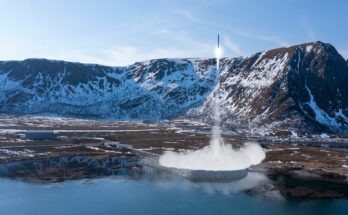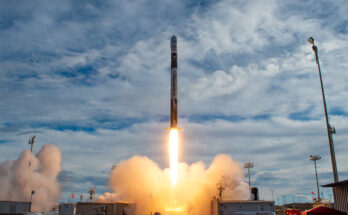by Bill Ostrove, Forecast International.
U.S. company United Launch Alliance (ULA) has unveiled its next-generation launch vehicle, dubbed Vulcan. In a much anticipated April 13 press conference, CEO Tory Bruno provided details about the new launch vehicle (formerly known as the Next Generation Launch System, or NGLS), including that it will feature a reusable main engine and a redesigned second stage that will extend on-orbit operating times from hours to weeks.
The Vulcan, which will replace the Atlas V and Delta IV, has been in the works for some time. A possible replacement was first introduced last September when ULA announced a partnership with Blue Origin to develop the BE-4 rocket engine, which would replace the RD-180 and power a future launch vehicle.
The Vulcan will be introduced in four phases. The first phase will include the development of a new rocket engine and first stage. ULA would like the first flight to take place in 2019. The primary choice for rocket engine is Blue Origin’s BE-4. Aerojet Rocketdyne is also working on its AR-1 engine, which will serve as a backup in case trouble arises with the BE-4. A down-select is expected in 2016.
The first-phase Vulcan will continue to use the Atlas V Centaur upper stage, which will enable the launch vehicle to maintain its human spaceflight certification so it can continue to carry spacecraft such as the CST-100 and Dream Chaser. In addition, use of the 4-meter and 5-meter fairings from Atlas V and Delta IV will continue. The first stage will also include new solid rocket boosters (SRBs). ULA expects to issue a Request for Proposals later this year to Orbital ATK and Aerojet Rocketdyne. The companies will compete to be a sole provider of SRBs to ULA.
In the second phase, ULA will introduce a replacement for the Centaur upper stage, known as the Advanced Cryogenic Evolved Stage (ACES). The new upper stage, which ULA expects to begin flight testing in 2023, will use an advanced internal combustion engine to pump primary fuel back into the main rocket engine, preventing boil off. This will allow the upper stage to use its primary fuel for orbital control rather than using helium or hydrazine as current upper stages do. It will also prevent boil-off of fuel, allowing the upper stage to remain operational in orbit for extended periods of time.
During the third developmental phase, ULA will work on making reusable components. Specifically, the company will focus on the rocket engine – the most expensive part of the first stage (ULA estimates the engine represents 65 percent of the rocket’s cost). Once the payload has been deployed, the rocket engine will detach from the first stage. It will then deploy a hypersonic decelerator and a parafoil to slow down. When it reenters the atmosphere, it will be grabbed mid-air by a helicopter and returned to a launch center to be reintegrated into the next launch vehicle.
Finally, during the last phase, ULA will develop a distributed lift capability. Because the new upper stage will be able to remain in orbit for extended periods and execute a number of burns, ULA will be able to deploy payloads in phases. Larger payloads could be deployed on multiple launches and assembled on-orbit.
The new launch vehicle is expected to have a lift capability about 20 percent higher than similar Atlas V and Delta IV launch vehicles. Furthermore, the Vulcan will be modular, enabling it to replace the entire EELV line, including the Delta IV Heavy. Early versions will have up to 1.1 million lbst, and prices will start at $100 million. ULA would not discuss total R&D costs, but said that in the past, engine development and launch vehicle development have each cost about $1 billion.
The Vulcan is ULA’s response to major changes taking place in the launch market. It addresses two problems that have arisen at ULA in recent years. The first is new competition from Space Exploration Technologies. SpaceX’s Falcon 9 is expected to be certified to carry national security payloads later this year. It is also significantly cheaper than Atlas V and Delta IV launch vehicles. SpaceX estimates it will be able to launch government payloads on both the Falcon 9 and larger Falcon Heavy for an average of $120 million per launch. ULA estimates its average per-launch cost at $225 million.
While the company was never mentioned during the press conference, SpaceX’s influence was clearly present. ULA will lower costs to be more competitive, and the company will also compete for launches differently than it has in the past. ULA currently works under two separate agreements: one for launch services and one to maintain launch infrastructure. This arrangement is not expected to last. While ULA would not discuss specific details on future contracts, the company will likely compete for each individual launch and will be paid a flat rate on a per-launch basis. Furthermore, ULA is paying for R&D with operational profits, rather than receiving RDT&E funding from the Pentagon.
The other major issue that the Vulcan addresses is replacement of the RD-180 engine – the main engine on the Atlas V. Supplied by Russian company Energomash, the engine has come under fire due to the conflict over Ukraine. Congress has demanded that the Air Force and ULA find a replacement for the venerable engine. The Vulcan will rely either on the Blue Origin BE-4 or the Aerojet Rocketdyne AR-1, both built by U.S. companies on American soil. A potential problem is that ULA only has enough RD-180s under contract to continue Atlas V launches until 2019. If Vulcan development experiences delays, there will not be enough RD-180s in stock to launch Atlas V missions. Therefore, ULA is asking Congress to allow it more flexibility in ordering RD-180 engines until the Vulcan is ready to take over for the Atlas V.
The Vulcan will help ULA to more efficiently provide launch services to the U.S. government. The new launch vehicle will replace two legacy systems, creating efficiencies. ULA will also operate launch vehicles from two launch pads rather than the five it currently operates, further reducing costs. With these savings, ULA even hopes to begin competing on the commercial market. At $100 million, starting costs will still be higher than SpaceX’s Falcon 9, which lists at $62 million. However, differences in performance or other services may make up for the price gap.
The original EELV program was initiated with the expectation that commercial launches would help spread costs out and lower overall prices. A commercial market for the Atlas V and Delta IV never materialized, as costs grew much higher than originally intended. It will likely never be a leader in the commercial market along with the Falcon 9, Ariane 5 (later Ariane 6), and Proton (later Angara); however, if ULA can keep costs down, the Vulcan may be able to successfully supplement U.S. government orders with commercial orders.
A military history enthusiast, Richard began at Forecast International as editor of the World Weapons Weekly newsletter. As the Internet grew in importance as a research tool, he helped design the company's Forecast Intelligence Center and currently coordinates the EMarket Alert newsletters for clients. Richard also manages social media efforts, including two new blogs: Defense & Security Monitor, covering defense systems and international issues, and Flight Plan, which focuses on commercial aviation and space systems. For over 30 years, Richard has authored the Defense & Aerospace Companies, Volume I (North America) and Volume II (International) services. The two books provide detailed data on major aerospace and defense contractors. He also edits the International Contractors service, a database that tracks all the contractors involved in the programs covered in the FI library. More recently he was appointed Manager, Information Services Group (ISG), a new unit that encompasses developing outbound content for both Forecast International and Military Periscope.



